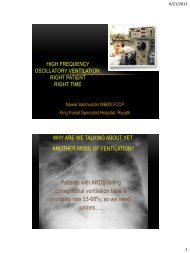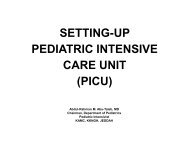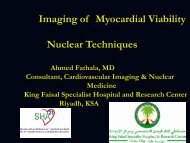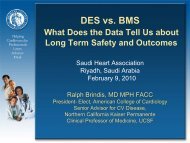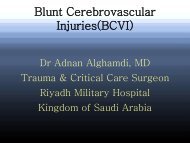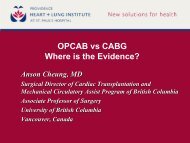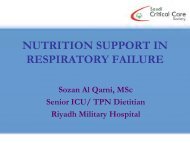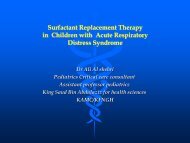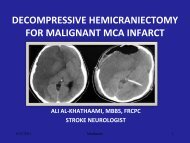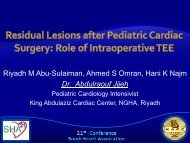Perioperative Cardiac Risk Assessment - RM Solutions
Perioperative Cardiac Risk Assessment - RM Solutions
Perioperative Cardiac Risk Assessment - RM Solutions
You also want an ePaper? Increase the reach of your titles
YUMPU automatically turns print PDFs into web optimized ePapers that Google loves.
<strong>Perioperative</strong> <strong>Cardiac</strong><br />
<strong>Risk</strong> <strong>Assessment</strong><br />
Dr.Hanan B. ALBackr , MBBS,FRCPC<br />
Assistant professor of Medicine<br />
Cardiology consultant<br />
King Fahad <strong>Cardiac</strong> Center, King Khalid University Hospital<br />
College of Medicine, King Saud University
Surgery or not<br />
• 87 year old female<br />
with known critical AS<br />
fall and breaks her hip.<br />
• No CHF, MI, syncope<br />
• Stable and relatively<br />
independent before the<br />
fall.<br />
• LVEF 65%<br />
• 82 year old male with<br />
known CAD. Stable<br />
angina pectoris.<br />
• Catheterization shows<br />
occluded LAD which<br />
was fed by collaterals<br />
• No CHF<br />
• H/O DM and HTN<br />
• Severe worsening<br />
spinal stenosis and<br />
weakness<br />
• LVEF 50%
Medical Consultation<br />
• The preoperative medical consultation provides an<br />
opportunity for the Consultant to contribute to a better<br />
surgical outcome for the patient.<br />
• Consultants are often asked to estimate the risk for<br />
perioperative cardiac ischemia, infarction, or death in patients<br />
undergoing non-cardiac surgery.<br />
• Estimating this risk can be difficult and complex because of<br />
heterogeneous studies and recommendations, although there<br />
is a growing body of evidence to guide the use of<br />
preoperative cardiac revascularization and pharmacologic<br />
treatment.
Preoperative cardiac<br />
issues<br />
• How healthy is the patient<br />
• How active is the patient<br />
• How risky is the planned surgery<br />
• Is preoperative cardiac testing<br />
necessary<br />
• What preventive measures can be<br />
taken to reduce cardiac risk
Outline I<br />
1. Coronary <strong>Risk</strong><br />
• Clinical Predictors<br />
• Functional Capacity<br />
• Surgery-Specific <strong>Risk</strong><br />
2. Other Cardiovascular Conditions<br />
• Hypertension<br />
• Valvular disease<br />
• Myocardial disease<br />
• Arrhythmias<br />
• ICD’s and pacemakers
Outline II<br />
3. Supplemental Preoperative<br />
<strong>Assessment</strong><br />
• LV function<br />
• 12-lead ECG<br />
• Noninvasive Stress Testing<br />
• Coronary Angiography<br />
4. <strong>Perioperative</strong> Management<br />
• Revascularization<br />
• Medical Therapy
JACC Vol. 50, No. 17, 2007<br />
ACC/AHA 2007 <strong>Perioperative</strong> Guidelines October 23, 2007:1707–32
JACC Vol. 50, No. 17, 2007<br />
ACC/AHA 2007 <strong>Perioperative</strong> Guidelines October 23, 2007:1707–32
JACC Vol. 50, No. 17, 2007<br />
ACC/AHA 2007 <strong>Perioperative</strong> Guidelines October 23, 2007:1707–32
Calculating the<br />
Clinical <strong>Risk</strong> Index
<strong>Risk</strong> Indices<br />
1963 – ASA physical<br />
status classification used<br />
Many different risk scores<br />
1977 - Goldman<br />
identified 9 cardiac<br />
risk factors<br />
• Simple models – multivariate analysis<br />
– <strong>Cardiac</strong> risk index (i.e. Goldman index)<br />
– Larsen risk index<br />
– Revised cardiac risk index (i.e. Lee index)<br />
– CCS index (i.e. Gilbert index)<br />
• Bayesian models<br />
– Detsky index<br />
– Veteran Affairs index<br />
1986 – Detsky added<br />
angina class & prior MI<br />
1997 – modified to stratify<br />
into 3 risk groups (ACP)
Detsky Modified <strong>Risk</strong> Index
Revised <strong>Cardiac</strong> <strong>Risk</strong> Index<br />
(LEE)<br />
• High-risk type of surgery<br />
• History of ischemic heart disease<br />
• History of congestive heart failure<br />
• History of cerebrovascular disease<br />
• Preoperative treatment with insulin<br />
• Preoperative serum creatinine >2.0<br />
Lee TH, Marcantonio ER, Mangione CM, et al. Derivation and prospective alidation<br />
of a simple index for prediction of cardiac risk of major noncardiac surgery.<br />
Circulation 1999;100:1043-
Grayburn, P. A. et. al. Ann Intern Med 2003;138:506-511
Validation of <strong>Risk</strong> Indices<br />
• Many of the indices validated prospectively<br />
individually<br />
– Mixed and controversial results<br />
• Attempts to compare risk scores<br />
– Heinisch et al. Arq Bras Cardiol 2002.<br />
• n=119 referred for cardiology consultation for<br />
noncardiac surgery<br />
– Gilbert et al. Ann Intern Med 2000.<br />
• n=2035 referred for medical consultation for<br />
elective/urgent noncardiac surgery
Comparison of <strong>Risk</strong> Indices<br />
Heinisch et al. Arq Bras Cardiol 2002 Gilbert et al. Ann Intern Med 2000<br />
d = 0.48<br />
d = 0.625<br />
d = 0.48<br />
d = 0.654<br />
d = 0.48<br />
d = 0.38<br />
d = 0.642<br />
d = 0.601
Part I: Coronary <strong>Risk</strong><br />
Stratification<br />
• Clinical Predictors<br />
• Functional Capacity<br />
• Surgery-Specific <strong>Risk</strong>
ACC/AHA Stepwise Approach<br />
Focuses on following features:<br />
1. Urgency of surgery<br />
2. Prior cardiac tests / treatment<br />
3. Clinical markers<br />
4. Functional capacity<br />
5. Surgery-specific risk
Preop <strong>Assessment</strong><br />
Need for<br />
noncardiac surgery<br />
Emergency<br />
Operating<br />
room<br />
Postop risk stratification<br />
and management<br />
Urgent or Elective<br />
No<br />
Coronary revasc<br />
within 5 yrs<br />
Yes<br />
Recurrent symptoms<br />
or signs<br />
No<br />
Yes<br />
Recent coronary<br />
evaluation<br />
Yes<br />
Recent coronary<br />
angiogram or XST<br />
Favourable<br />
Operating<br />
room<br />
No<br />
Clinical<br />
predictors<br />
Unfavourable<br />
or change in Sx’s<br />
Major<br />
clinical predictors<br />
Intermediate<br />
clinical predictors<br />
Minor or No<br />
clinical predictors
Major Clinical Predictors<br />
Major<br />
clinical predictors<br />
1. Unstable coronary syndrome<br />
2. Decompensated CHF<br />
3. Significant arrhythmia<br />
4. Severe valvular disease<br />
Consider delay or<br />
cancel surgery<br />
Consider coronary<br />
angiography<br />
Medical management<br />
and RF modification<br />
Care dictated by<br />
findings & Rx results
Intermediate Clinical Predictors<br />
Intermediate<br />
clinical predictors<br />
1. Mild angina or prior MI<br />
2. Compensated or prior CHF<br />
3. Diabetes mellitus<br />
4. Renal insufficiency<br />
Poor functional capacity<br />
(4 METs)<br />
1. Functional<br />
Capacity<br />
High surgical risk Intermediate risk Low risk<br />
2. Surgical<br />
<strong>Risk</strong><br />
Noninvasive<br />
testing<br />
Low risk<br />
Operating<br />
room<br />
Postop risk<br />
stratification &<br />
RF modification<br />
3. Noninv<br />
Testing<br />
High risk<br />
Consider coronary<br />
angiography<br />
Care dictated by<br />
findings & Rx results<br />
4. Invasive<br />
Testing
Minor or No Clinical Predictors<br />
Minor or No<br />
clinical predictors<br />
Poor functional capacity<br />
(4 METs)<br />
1. Advanced age<br />
2. Abnormal ECG<br />
3. Non-sinus rhythm<br />
4. Low functional capacity<br />
5. Prior CVA<br />
6. Uncontrolled HTN<br />
1. Functional<br />
Capacity<br />
High surgical<br />
risk<br />
Intermediate<br />
or low risk<br />
2. Surgical<br />
<strong>Risk</strong><br />
Noninvasive<br />
testing<br />
Low risk<br />
Operating<br />
room<br />
Postop risk<br />
stratification &<br />
RF modification<br />
3. Noninv<br />
Testing<br />
High risk<br />
Consider coronary<br />
angiography<br />
Care dictated by<br />
findings & Rx results<br />
4. Invasive<br />
Testing
Functional Capacity<br />
1 MET<br />
4 METs<br />
• Self-care<br />
• Eat, dress, toilet<br />
• Walk indoors<br />
• Walk 1 block slowly<br />
• Light housework<br />
4 METs<br />
• 1 flight of stairs<br />
• Brisk walk<br />
• Short run<br />
• Heavy housework<br />
• Moderate recreation<br />
• Strenuous sport<br />
10 METs
Surgery-Specific <strong>Risk</strong>
Stepwise Approach Summary<br />
No further testing if:<br />
• Emergency surgery precludes testing<br />
• Revascularization
Short-Cut Tool<br />
• Majority of patients have intermediate or<br />
minor clinical predictors<br />
Non-invasive testing required if > 2 of:<br />
1. Intermediate clinical predictor<br />
• CCS I/II, stable CHF, DM, renal insufficiency<br />
2. Poor functional capacity (
• After estimating a patient’s risk of adverse<br />
perioperative cardiac events from the Revised LEE<br />
<strong>Cardiac</strong> <strong>Risk</strong> Index or another index, then the<br />
physician must decide to proceed with further<br />
cardiac testing, pharmacologic management, both,<br />
or neither.<br />
• The most difficult to manage group is the<br />
intermediate risk patient…and a lot of our patients<br />
end up in this category.
Defining the role of noninvasive<br />
testing
Strengths and Weaknesses of<br />
Preoperative Noninvasive <strong>Cardiac</strong><br />
Testing<br />
• Although the negative predictive value of dobutamine<br />
echocardiography and nuclear perfusion tests for<br />
perioperative MI and death is close to 100%, the positive<br />
predictive value is quite low ~20%<br />
Wesorick DH, Eagle KH. Am J Med 2005; 118, 1413.e1-1413.e9
Does perioperative administration of betablockers<br />
reduce or eliminate the need for<br />
noninvasive preoperative cardiac testing in<br />
Intermediate risk patients
Predicators of <strong>Cardiac</strong> Events After<br />
Major Vascular Surgery<br />
Role of Clinical Characteristics, Dobutamine<br />
Echocardiography, and Betablocker Therapy<br />
Boersma E, Poldermans D, Bax JJ, et al. JAMA 2001; 285: 1865-73
Estimate of the <strong>Perioperative</strong> <strong>Risk</strong> of<br />
<strong>Cardiac</strong> Death or Myocardial Infarcation
Results<br />
Clinical risk score B-Blockers <strong>Cardiac</strong><br />
complications<br />
0-2 and DES result not<br />
considered<br />
3 or more<br />
But no WMA<br />
+ 6%
Conclusions<br />
• <strong>Perioperative</strong> cardiac event rate was low<br />
(
Conclusions<br />
Dobutamine stress echo is useful to further risk<br />
stratify patients with a clinical risk score of 3 or<br />
more.<br />
– Patients with a risk factor of 3 but without stress induced<br />
ischemia had a low perioperative risk of cardiac events in<br />
the setting of beta-blocker therapy.<br />
– Patients with a risk factor of 3 or more and new wall motion<br />
abnormalities (NWMA’s), specifically patients with >4<br />
segments involved were not adequately protected with<br />
betablockers, <strong>Cardiac</strong> catheterization and revascularization<br />
should be considered in these
Should major vascular surgery be delayed<br />
because of preoperative cardiac testing in<br />
intermediate-risk patients receiving<br />
betablocker therapy with tight heart rate<br />
control<br />
Poldermans D, Bax JJ, Schouton O, et al; Dutch Echocardiographic<br />
<strong>Cardiac</strong> <strong>Risk</strong> Evaluation Applying Stress Echo Study Group
Intervention<br />
• Preoperative cardiac stress testing<br />
with dobutamine stress echo or<br />
perfusion scintigraphy (n=386) or no<br />
testing ( n=384)<br />
• All patients received perioperative<br />
beta-blockers titrated to a target<br />
resting HR of 60-65 beats/min.
Results<br />
- At 30 days, the frequency of cardiac death and non- fatal<br />
MI was similar in the testing and no testing groups.<br />
-No difference in 2-year outcome was observed between the<br />
groups.<br />
- Testing delayed surgery an average of 3 weeks.<br />
- In both testing and no testing groups, patients with a heart<br />
rate less than 65 had a significant decrease in the number<br />
of cardiac deaths and non-fatal MI’s
Poldermans, et al<br />
• Regardless of testing or no testing,<br />
patients with beta-blockers titrated to<br />
tight HR control (HR
Part III: Supplemental<br />
Preoperative Testing<br />
• 12-lead ECG<br />
• LV function<br />
• Noninvasive Stress Testing<br />
• Coronary Angiography
Resting LV Function<br />
• In general, not a consistent predictor<br />
of perioperative ischemic events<br />
– LVEF
Who to do stress test<br />
on
Stress Testing<br />
Class I<br />
Class IIa<br />
Class IIb<br />
Class III<br />
1. Dx of CAD with intermediate pretest probability<br />
2. Prognostication in initial evaluation of CAD or in<br />
those with change in clinical status<br />
3. Evaluation of ischemia prior to PCI<br />
4. Evaluation of adequacy of medical Rx<br />
1. Exercise capacity when history unreliable<br />
1. Dx of CAD with high/low pretest probability<br />
2. Detection of restenosis in high risk<br />
asymptomatic patients following PCI<br />
1. Routine screening if asymptomatic<br />
2. Severe comorbidity precluding revascularization<br />
3. For isolated ectopic beats in young patients<br />
Fleisher LA, Beckman JA, Brown KA, Calkins H, Chaikof E, Fleischmann KE, Freeman WK, Froehlich<br />
JB, Kasper EK, Kersten JR, Riegel B, Robb J Am Coll Cardiol 2006; 47: 2343-55.
Part IV: <strong>Perioperative</strong><br />
Management<br />
• Revascularization<br />
• Medical Therapy
Still a paucity of strong evidence for perioperative management
Preoperative CABG<br />
• Evidence:<br />
– Retrospective cohorts show prior CABG reduces<br />
periop events<br />
– However, no randomized controlled trials<br />
• Rarely indicated for noncardiac surgery<br />
• Only indicated for high risk coronary<br />
anatomy scheduled for interm-high risk<br />
elective noncardiac surgery
Coronary-Artery Revascularization<br />
Before Elective Major Vascular Surgery<br />
(CARP)<br />
McFalls EO, Ward HB, Moritz TE, et al. N Engl J<br />
Med 2004;351: 2795-804
Study design<br />
• Prospective randomized study<br />
• 510 patients randomized to either<br />
coronary-artery revascularization or No<br />
revascularization before surgery<br />
• Within the Revascularization group<br />
• 59% PCI<br />
• 41% CABG
Conclusions<br />
• Coronary artery revascularization before elective<br />
surgery does not alter long-term survival.<br />
• There was also no reduction in early postoperative<br />
deaths, myocardial infarctions, or length of stay.<br />
• Coronary artery revascularization before elective<br />
vascular surgery among patients with stable cardiac<br />
symptoms cannot be recommended.
• With the exclusion of very high risk patients<br />
and the optimization of medical<br />
management in both groups , coronary<br />
revascularization did not provide an<br />
additional benefit.
Coronary artery stenting and<br />
noncardiac surgery – a prospective<br />
outcomes study<br />
VICENZE MN, MEISLITZER T, HEITZINGER B, ET AL. BR J<br />
ANAESTH. 2006; 96:686-693
Results and Conclusion<br />
• 45% of all patients had cardiovascular<br />
complications<br />
- 9% death<br />
-21% redo PCI<br />
- 9% unstable angina<br />
7% of patients had significant bleeding<br />
Adverse cardiovascular event rates are high among patients<br />
who receive a coronary stent within one year before<br />
noncardiac surgery.
Conclusion<br />
• Adverse cardiovascular event rates are<br />
high among patients who receive a<br />
coronary stent within one year before<br />
noncardiac surgery.<br />
• A standardized heparin and<br />
antiplatelet protocol does not decrease<br />
risk
Preoperative PCI
Preoperative PCI<br />
• No randomized trials<br />
• Observational studies:<br />
– Periop cardiac death infrequent with PCI prior to<br />
noncardiac surgery<br />
– May lead to emergency CABG<br />
• Timing<br />
– Uncertainty of time b/w PCI and surgery<br />
– > 1 week for PTCA<br />
– > 2 weeks (ideally 4-6 weeks) for stent
Coronary artery bypass grafting is superior<br />
to percutaneous coronary<br />
intervention in prevention of<br />
perioperative myocardial infarctions<br />
during subsequent vascular surgery.<br />
Ward HB, Kelly RF, Thottapurathu L, et al. Ann Thorac Surg.<br />
2006; 82: 795-801.
Significantly more non-fatal MI’s in the PCI treated patients:<br />
• PCI 16.8%<br />
• CABG 6.6%<br />
No significant difference in mortality rates between the<br />
two groups:<br />
• PCI 3.8%<br />
• CABG 2.2 %<br />
No significant difference:<br />
• length of stay<br />
• left ventricular ejection fraction at 3 months<br />
• Mortality at 2.7 years<br />
• Need for additional coronary revascularization
• Where does this leave us regarding<br />
recommendations for periopoerative<br />
revascularization
Conclusion<br />
• For patients with stable coronary artery disease and no<br />
independent need for revascularization, medical therapy is<br />
preferred.<br />
• In patients who have independent indications for coronary<br />
revascularization (Unstable angina, Left main disease, or<br />
3-vessel coronary disease with impaired LV function),<br />
both strategies have disadvantages<br />
• CABG carries it’s own higher procedural mortality<br />
• PCI carries a higher perioperative event risk, and use of<br />
PTCA alone does not decrease this risk.
Pharmacologic Myocardial<br />
Protection in Patients Undergoing<br />
Noncardiac Surgery: A<br />
Quantitative Systematic Review<br />
Stevens RD, Burri H, Tramer MR. Pharmacologic myocardial protection<br />
in patients undergoing noncardiac surgery: a quantitative systematic<br />
review. Anesth Analg 2003; 97:623-33.
Preoperative Medical Rx
Conclusion<br />
• B-blockers and alpha2-agonists offer significant protection<br />
against cardiac morbidity in patients undergoing major<br />
noncardiac surgery<br />
• For every 100 patients receiving a B-blocker:<br />
– 13 (NNT 8) will be prevented from having intra- or<br />
postoperative ischemia.<br />
– 4 (NNT 23) will not have an MI.<br />
– 3 (NNT 32)deaths will be prevented.<br />
• For every 100 patients receiving an Alpha2-agonist:<br />
– 1.5 (NNT 73) deaths will be prevented.
Use of perioperative B-<br />
blockade!!!
<strong>Perioperative</strong> Beta-Blockers<br />
• 10 small published noncardiac surgery RCTs<br />
• 855 patients randomized<br />
– 467 treatment<br />
– 388 control<br />
• Very few events<br />
– 20 deaths (15 were cardiac)<br />
– 18 non-fatal MIs<br />
• Results dominantly from one study<br />
Poldermans
<strong>Perioperative</strong> Beta-Blockers<br />
Meta-Analysis: All-cause Mortality
<strong>Perioperative</strong> Beta-Blockers<br />
Meta-Analysis: Non-Fatal MI
<strong>Perioperative</strong> Medical Rx<br />
Recommendations:<br />
• Beta-Blockers<br />
– I: If required in past to control angina,<br />
symptomatic arrhythmia, or hypertension<br />
– IIa: Untreated HTN, known CAD, major risk<br />
factors for CAD<br />
• Alpha-Blockers<br />
– IIb: Periop control of HTN, known CAD, major<br />
risk factors for CAD<br />
• Still very few well-designed trials<br />
– POISE currently enrolling (goal of n=10 000)
SUMMARY<br />
• <strong>Risk</strong> Stratification:<br />
1. Urgency of surgery<br />
2. Prior cardiac tests / treatment<br />
3. Clinical markers (Major, Intermediate, and Minor)<br />
4. Functional capacity (
What Does the Future Hold<br />
<br />
POISE<br />
• International study, funded by the Canadian Institutes of Health<br />
Research.<br />
• 10,000 patients/ 75 centers/9 countries.<br />
• Evaluate the efficacy of 30 days of controlled release metoprolol to<br />
prevent cardiovascular death, nonfatal MI , nonfatal cardiac arrest in<br />
patients undergoing all types of noncardiac surgery<br />
<br />
DECREASE IV<br />
• Currently ongoing<br />
• Looks at fluvastatin and bisoprolol for the reduction of perioperative<br />
cardiac mortality and morbidity in high-risk patients undergoing<br />
noncardiac surgery
Thanks



